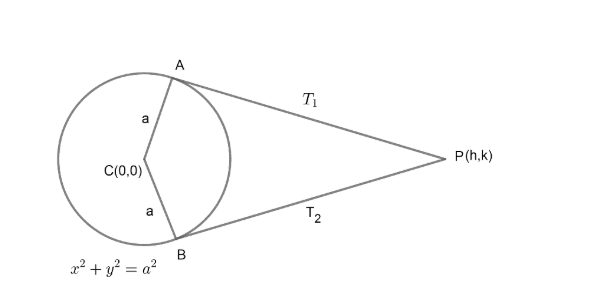Question
Question: The tangents to the circle \({{x}^{2}}+{{y}^{2}}={{a}^{2}}\) having inclinations \(\alpha \text{ and...
The tangents to the circle x2+y2=a2 having inclinations α and β intersect at P. If cotα+cotβ=0, then the locus of P is
(A) x + y = 0
(B) x – y = 0
(C) xy = 0
(D) None of these
Solution
Hint: Use equation of tangent formula from an external point to circle x2+y2=a2. Form the quadratic and relate the roots with the coefficients of quadratic.
The given equation of circle is,
x2+y2=a2……………….(1)
Two tangents having inclination α and β which means they are making angles α and β with x – axis intersecting at P as shown in diagram.
As centre of circle given is (O,O) and radius = a if we compare it with standard equation of circle
(x−x1)2+(y−y1)2=a2
Where (x1,y1) is centre and a is radius.

Let point P is (h, k) of which we have to find locus.
Now, we have two tangents T1 and T2 with inclinations α and β. Hence, slopes of tangents T1 and T2 be tanα and tanβ as slope is tan of angle of any line with positive direction of x – axis.
We have given relation from question;
cotα+cotβ=0…………………… (2)
As, we know that tangent from any external point of circle x2+y2=a2 with slope given as m is ;
y=mx±am2+1 ………………. (3)
Where m is slope of tangent
a = radius of circle
Let us simplify equation (3) as;
y−mx=±am2+1
Squaring both sides of above equation;
(y−mx)2=a2(m2+1)y2+m2x2−2myx=a2m2+a2
Rewriting the above equation with quadratic in ‘m’, we get;
m2(a2−x2)+2myx+a2−y2=0 ………………… (4)
Now, we have a quadratic in ‘m’ which means it will have two roots. Let m1 and m2 are roots of equation (4).
As tangents are drawn from an external point and only two tangents can be drawn from any external point to circle.
Let these slopes represent tangents T1 and T2, which has slope tanα and tanβ.
Hence, m1=tanα,m2=tanβ are roots of equation (4);
As we know, if we have quadratic Ax2+Bx+C, then
sum of roots =A−Bproduct of roots = AC
From equation (4), we get;
tanα+tanβ=a2−x2−2xytanα+tanβ=a2−x2a2−y2
As, tangents T1 and T2 with slopes tanα and tanβ are intersecting at (h, k). Hence, we can replace (x, y) by (h, k).
Therefore,
tanα+tanβ=a2−h2−2xy..............(5)tanα+tanβ=a2−h2a2−k2...............(6)
From equation (2), we have;
cotα+cotβ=0
We know that cotθ=tanθ1
Hence,
tanα1+tanβ1=0tanαtanβtanα+tanβ=0tanα+tanβ=0............(7)
Now, from equation (5), we have;
tanα+tanβ=a2−h2−2hk ……………….. (8)
From equation (7) & (8), we get;
a2−h2−2hk=0hk=0
Now, replacing (h, k) by (x, y) to get locus;
xy = 0 (Required locus)
Hence, the correct answer is option (C).
Note: Another approach for this question would be that we can suppose point A and B as parametric coordinates. Point A as (acosθ1,bsinθ1) and point B as (acosθ2,bsinθ2).
Now, write equation of tangents through A and B as T = 0
Tangents through A and B as
axcosθ1+bysinθ1=1axcosθ2+bysinθ2=1
Hence, slope of tangents A and B is given as;
bsinθ1a−cosθ1=a−cosθ1×sinθ1b=asinθ1−bcosθ1
Similarly, tangents through B has
slope=a−bsinθ2cosθ2
We have slopes given as tanα and tanβ.
Hence, we have equations
tanα=a−bsinθ1cosθ1=a−bcotθ1tanβ=a−bsinθ2cosθ2=a−bcotθ2
Now, find intersection point (h, k) by solving equations of tangents written above try to eliminate θ1&θ2 with the help of given relation cotα+cotβ=0,and given above i.e. tanα=a−bcotθ1,tanβ=a−bcotθ2.
One can go wrong while writing the relations tanα+tanβand tanα.tanβ from the quadratic (y−mx)2=a2(m2+1)
